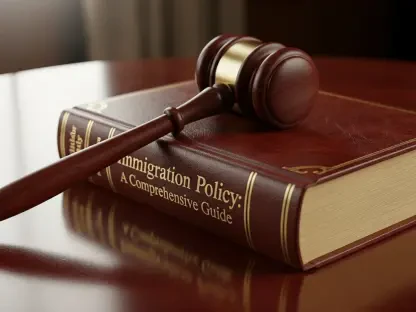Overview of Employment Law and Supreme Court Influence
Imagine a landscape where the rules governing workplaces shift overnight, driven by decisions made in the highest court of the land, leaving HR professionals scrambling to adapt to new legal standards and compliance requirements. Employment law stands as a critical framework that dictates how businesses manage their workforce, ensuring fairness, safety, and compliance. At present, this field encompasses a wide array of regulations, from anti-discrimination statutes to wage and hour laws, all of which directly affect HR operations. The significance for HR lies in maintaining a balance between protecting employee rights and meeting employer obligations, a task often complicated by evolving legal interpretations.
The Supreme Court plays a pivotal role in shaping these workplace policies through landmark rulings that set precedents for federal and state regulations. Its decisions influence key areas such as hiring practices, benefits administration, and dispute resolution mechanisms. Federal agencies like the Equal Employment Opportunity Commission (EEOC) and the National Labor Relations Board (NLRB) often adjust their enforcement priorities based on judicial outcomes, creating a ripple effect across industries. For HR, staying abreast of these changes is essential to avoid legal pitfalls and maintain operational stability.
Stakeholders in this arena extend beyond employers and employees to include policymakers, legal experts, and advocacy groups, all of whom watch Supreme Court dockets closely. The potential impact of judicial decisions cannot be overstated, as they may redefine compliance requirements or alter the scope of employee protections. This dynamic environment demands that HR professionals remain vigilant, ready to revise policies in response to new legal standards established by the court.
Key Cases and Petitions on the Docket
Significant Legal Battles Shaping HR
Several high-profile Supreme Court cases and petitions currently under consideration promise to reshape the landscape of employment law with direct consequences for HR practices. Among them, a case involving Federal Trade Commissioner Rebecca Slaughter challenges executive authority over independent agencies, questioning whether officials can be removed without cause. Other disputes address pension liabilities under the Employee Retirement Income Security Act (ERISA), arbitration agreement exemptions for transportation workers, religious accommodations under Title VII, and disability discrimination interpretations under the Americans with Disabilities Act (ADA). Each of these legal battles carries significant implications for workplace policies.
Specific cases, such as M & K Employee Solutions, LLC v. Trustees of the IAM National Pension Fund, focus on technical aspects of withdrawal liability calculations for multiemployer pension plans, potentially affecting millions in benefits. Meanwhile, Flowers Foods, Inc. v. Brock seeks to clarify whether local delivery drivers fall under the Federal Arbitration Act’s interstate commerce exemption, which could limit or expand employers’ ability to enforce arbitration clauses. Additionally, petitions like Does 1-2 v. Hochul tackle the clash between state mandates and federal religious accommodation laws, spotlighting vaccine exemption disputes. These cases collectively signal potential shifts in legal standards that HR must monitor closely.
Potential Outcomes and HR Implications
The range of possible rulings in these cases presents diverse outcomes that could significantly alter HR policy frameworks. For instance, a decision affirming executive power to remove agency officials without cause might lead to rapid policy changes at bodies like the EEOC, introducing uncertainty in the enforcement of workplace rules. On the pension front, a ruling against employers in the M & K case could impose unforeseen financial burdens, necessitating adjustments in benefits planning. Similarly, a narrow interpretation of arbitration exemptions may preserve cost-effective dispute resolution options, while a broader one could heighten litigation risks.
Looking ahead, these judicial outcomes are likely to influence long-term HR strategies in profound ways. A shift toward greater executive control over agencies might compel HR to develop more agile compliance systems to handle fluctuating regulations. Financial liabilities arising from pension disputes could push organizations to reevaluate retirement offerings, impacting employee retention and satisfaction. As such, HR departments must prepare for varied scenarios, ensuring that workforce management practices remain adaptable to whatever legal standards emerge from the court’s decisions.
Challenges for HR in Navigating Judicial Decisions
The uncertainty surrounding Supreme Court rulings poses substantial challenges for HR professionals tasked with maintaining compliant and effective workplace policies. Regulatory ambiguity often arises when judicial outcomes are pending, making it difficult to predict enforcement priorities or legal obligations. This unpredictability is compounded by the tension between federal and state laws, as seen in cases involving religious accommodations where state mandates may conflict with federal protections, leaving employers in a legal gray area.
Further complicating matters are fluctuating agency priorities, especially if executive influence over bodies like the NLRB increases, potentially leading to abrupt shifts in workplace regulations. The risk of litigation also looms large, particularly in areas like arbitration and disability discrimination, where unclear legal standards could invite lawsuits. HR must contend with these issues while striving to maintain consistent employee relations and operational efficiency, a balancing act that requires strategic foresight.
To mitigate these challenges, HR leaders can adopt flexible policy frameworks that allow for quick adjustments once rulings are issued. Engaging legal counsel to interpret potential outcomes and conducting regular policy reviews can help anticipate changes. Additionally, fostering open communication with employees about evolving legal requirements ensures transparency and minimizes misunderstandings during periods of transition, equipping HR to navigate the complex judicial landscape more effectively.
Regulatory Landscape and Compliance Considerations
Supreme Court decisions do not operate in a vacuum; they intersect with a broader regulatory environment that governs workplace practices across the nation. Key statutes such as Title VII of the Civil Rights Act, ERISA, and the ADA form the backbone of employment law, dictating standards for discrimination prevention, benefits management, and accessibility. Judicial rulings often reinterpret these laws, prompting HR to update policies on issues ranging from religious accommodations to health-related inquiries in hiring processes.
Compliance remains a cornerstone of HR responsibility, particularly in nuanced areas like balancing religious exemptions with organizational needs or ensuring pension plans meet fiduciary duties. A potential ruling expanding the ADA’s scope to cover nondisabled individuals, for example, could necessitate revisions to medical examination policies to avoid violations. Similarly, shifts in ERISA standards might require closer scrutiny of investment options in retirement plans, adding layers of complexity to benefits administration.
The interplay between federal authority and state mandates further shapes the compliance landscape, as discrepancies can create operational challenges for multistate employers. HR must strive to harmonize policies across jurisdictions while adhering to the highest applicable standards. Staying informed about judicial outcomes and their regulatory ripple effects is crucial for maintaining lawful practices and safeguarding against penalties in this intricate legal framework.
Future Directions for HR Amid Legal Shifts
As employment law continues to evolve through Supreme Court rulings, HR professionals must anticipate where policies and practices are headed to stay ahead of the curve. Current cases suggest a trajectory toward potential increases in executive control over regulatory agencies, which could accelerate policy changes and disrupt long-standing workplace norms. This trend, coupled with emerging employee rights issues, signals a need for HR to prioritize adaptability in policy design over the coming years.
Emerging disruptors also include the financial stakes tied to benefits management, as seen in pension and ERISA disputes that could redefine employer liabilities. Additionally, evolving interpretations of discrimination protections and arbitration agreements may reshape how conflicts are resolved and how diversity is supported in the workplace. These shifts underscore the importance of proactive monitoring of legal developments to ensure that HR strategies align with new judicial standards.
Innovation will be key to navigating this uncertain terrain, with HR encouraged to explore technology-driven solutions for compliance tracking and employee engagement. Building partnerships with legal experts to forecast potential impacts of court decisions can provide a competitive edge. Ultimately, a forward-thinking approach that embraces change and prioritizes employee well-being will position HR departments to thrive amid the legal transformations on the horizon.
Conclusion and Strategic Recommendations for HR
Reflecting on the array of Supreme Court cases discussed, it becomes evident that their outcomes hold the power to reshape HR policies in fundamental ways, from agency oversight to employee protections. Each case, whether addressing pension liabilities or religious accommodations, carries implications that demand attention from HR leaders across industries. The potential for regulatory upheaval and redefined legal standards emerges as a central theme throughout the analysis.
Looking ahead, actionable steps surface as critical for HR professionals navigating this pivotal moment. Staying informed on judicial outcomes through regular updates and legal briefings proves essential to anticipate policy shifts. Revising compliance frameworks to incorporate flexibility allows for swift adaptation to new rulings, while preparing for regulatory changes through scenario planning mitigates risks. Engaging with industry peers to share best practices also offers valuable insights during this period of transition.
Beyond immediate responses, a broader perspective highlights the evolving role of HR in balancing legal obligations with organizational goals. Investing in training programs to educate staff on emerging legal standards becomes a priority to maintain a compliant workplace culture. By fostering a proactive mindset and leveraging resources to address these judicial developments, HR solidifies its position as a strategic partner in steering organizations through the complexities of employment law changes.









